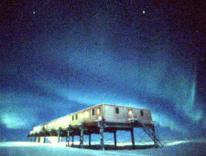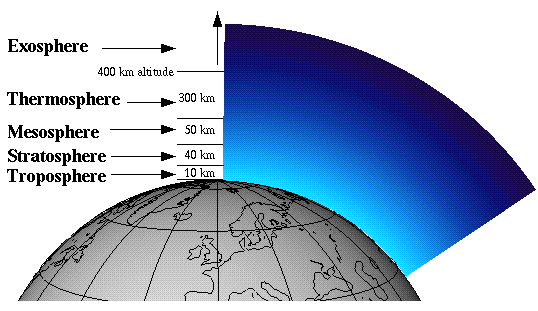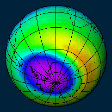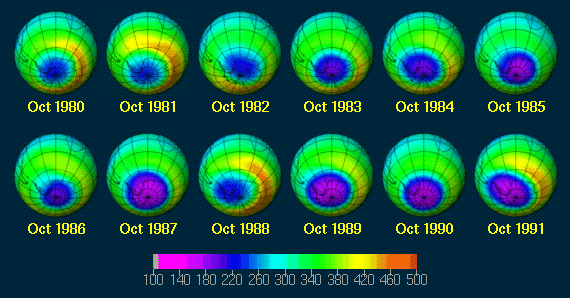

 Dramatic loss of ozone in the lower stratosphere over Antarctica was first
noticed in the 1970s by a research group from the British
Antarctic Survey (BAS) who were monitoring the atmosphere above Antarctica
from a research station much like the picture to the right.
Dramatic loss of ozone in the lower stratosphere over Antarctica was first
noticed in the 1970s by a research group from the British
Antarctic Survey (BAS) who were monitoring the atmosphere above Antarctica
from a research station much like the picture to the right.
The Halley Research Station - Information
BAS research stations in the Antarctic
Folklore has it that when the first measurements were taken in 1985, the drop in ozone levels in the stratosphere was so dramatic that at first the scientists thought their instruments were faulty. Replacement instruments were built and flown out, and it wasn't until they confirmed the earlier measurements, several months later, that the ozone depletion observed was accepted as genuine.
Another story goes that the TOMS satellite data didn't show the dramatic loss of ozone because the software processing the raw ozone data from the satellite was programmed to treat very low values of ozone as bad readings! Later analysis of the raw data when the results from the British Antarctic Survey team were published, confirmed their results and showed that the loss was rapid and large-scale; over most of the Antarctica continent.
Ozone (O3 : 3 oxygen atoms) occurs naturally in the atmosphere.
 The earth's
atmosphere is composed of several layers. We live in the "Troposphere"
where most of the weather occurs; such as rain, snow and clouds. Above the
troposphere is the "Stratosphere";
an important region in which effects such as the Ozone Hole and Global Warming
originate. Supersonic jet airliners such as Concorde fly in the lower
stratosphere whereas subsonic commercial airliners are usually in the
troposphere. The narrow region between these two parts of the atmosphere is
called the "Tropopause".
The earth's
atmosphere is composed of several layers. We live in the "Troposphere"
where most of the weather occurs; such as rain, snow and clouds. Above the
troposphere is the "Stratosphere";
an important region in which effects such as the Ozone Hole and Global Warming
originate. Supersonic jet airliners such as Concorde fly in the lower
stratosphere whereas subsonic commercial airliners are usually in the
troposphere. The narrow region between these two parts of the atmosphere is
called the "Tropopause".
Ozone forms a layer in the stratosphere, thinnest in the tropics (around the equator) and denser towards the poles. The amount of ozone above a point on the earth's surface is measured in Dobson units (DU) - typically ~260 DU near the tropics and higher elsewhere, though there are large seasonal fluctuations. It is created when ultraviolet radiation (sunlight) strikes the stratosphere, dissociating (or "splitting") oxygen molecules (O2) to atomic oxygen (O). The atomic oxygen quickly combines with further oxygen molecules to form ozone:
| O2 + hv | -> | O + O | (1) |
| O + O2 | -> | O3 | (2) |
It's ironic that at ground level, ozone is a health hazard - it is a major constituent of photochemical smog. However, in the stratosphere we could not survive without it. Up in the stratosphere it absorbs some of the potentially harmful ultra-violet (UV) radiation from the sun (at wavelengths between 240 and 320 nm) which can cause skin cancer and damage vegetation, among other things.
Although the UV radiation splits the ozone molecule, ozone can reform through the following reactions resulting in no net loss of ozone:
| O3 + hv | -> | O2 + O | (3) |
| O + O2 | -> | O3 | (2) as above |
Ozone is also destroyed by the following reaction:
| O + O3 | -> | O2 + O2 | (4) |
The reactions above, labelled (1)-(4) are known as the "Chapman reactions". Reaction (2) becomes slower with increasing altitude while reaction (3) becomes faster. The concentration of ozone is a balance between these competing reactions. In the upper atmosphere, atomic oxygen dominates where UV levels are high. Moving down through the stratosphere, the air gets denser, UV absorption increases and ozone levels peak at roughly 20km. As we move closer to the ground, UV levels decrease and ozone levels decrease. The layer of ozone formed in the stratosphere by these reactions is sometimes called the 'Chapman layer'.
But there was a problem with the Chapman theory. In the 1960s it was realised that the loss of ozone given by reaction (4) was too slow. It could not remove enough ozone to give the values seen in the real atmosphere. There had to be other reactions, faster reactions that were controlling the ozone concentations in the stratosphere. We'll learn about these in Part III of this tour of the ozone hole.
The Ozone Hole often gets confused in the popular press and by the general public with the problem of global warming. Whilst there is a connection because ozone contributes to the greenhouse effect, the Ozone Hole is a separate issue. However it is another stark reminder of the effect of man's activities on the environment.
Over Antarctica (and recently over the Arctic), stratospheric ozone has been depleted over the last 15 years at certain times of the year. This is mainly due to the release of manmade chemicals containing chlorine such as CFC's (ChloroFluoroCarbons), but also compounds containing bromine, other related halogen compounds and also nitrogen oxides (NOx). CFC's are a common industrial product, used in refrigeration systems, air conditioners, aerosols, solvents and in the production of some types of packaging. Nitrogen oxides are a by-product of combustion processes, eg aircraft emissions.
A more detailed description of the chemistry will follow in Part III.
The current levels of depletion have served to highlight a surprising degree of instability of the atmosphere, and the amount of ozone loss is still increasing. GreenPeace have documented many of the concerns that this raises.
The first global agreement to restrict CFCs came with the signing of the Montreal Protocol in 1987 ultimately aiming to reduce them by half by the year 2000. Two revisions of this agreement have been made in the light of advances in scientific understanding, the latest being in 1992. Agreement has been reached on the control of industrial production of many halocarbons until the year 2030. The main CFCs will not be produced by any of the signatories after the end of 1995, except for a limited amount for essential uses, such as for medical sprays.
The countries of the European Community have adopted even stricter measures than are required under the Montreal Protocol agreements. Recognising their responsibility to the global environment they have agreed to halt production of the main CFCs from the beginning of 1995. Tighter deadlines for use of the other ozone-depleting compounds are also being adopted.
It was anticipated that these limitations would lead to a recovery of the ozone layer within 50 years of 2000; the World Meteorological Organisation estimated 2045 (WMO reports #25, #37), but recent investigations suggest the problem is perhaps on a much larger scale than anticipated.
The above is transferred from http://www.atm.ch.cam.ac.uk/tour/part1.html
 There are now many measurements and observations of the changes in ozone that
occur over Antarctica. Such measurements come from ground based instruments at
the Antarctica research stations, from aircraft during scientific missions and
from satellites.
There are now many measurements and observations of the changes in ozone that
occur over Antarctica. Such measurements come from ground based instruments at
the Antarctica research stations, from aircraft during scientific missions and
from satellites.
Ozone loss was first detected in the stratosphere over the Antarctic (see Part I). Although mid-latitude and Arctic depletion has also been observed, the loss is most dramatic in the lower stratosphere over the Antarctica continent, where nearly all the ozone is destroyed over an area the size of Antarctica within a layer in the lower stratosphere that's many km thick.
The graph to the right shows the measured total ozone above the Halley Bay station in Antarctica. Each point represents the average total ozone for the month of October. Note the sudden change in the curve after about 1975. By 1994, the total ozone in October was less than half its value during the 1970s, 20 years previous. This dramatic fall in ozone was caused by the use of man-made chemicals known as 'halogens' which include the well-known CFCs commonly used in fridges and so on. These CFCs had made their way into the upper atmosphere where the much stronger UV radiation from the Sun had broken them down into their component molecules, releasing the potentially damaging chlorine (and bromine) atoms, which, given the right conditions, could destroy ozone. We'll learn more about the chemistry behind the loss of ozone in Part III of this tour.
Regular ozone measurement have been made from the Halley Bay Research Station for many years. Ozone depletion is most marked in the Antarctic Spring, around October.
 |
Inline movie
of TOMS ozone measurements from Nov 1978 to Jan 1992 (3.7 Mb) |
|
| MPEG
movie of TOMS ozone measurements from Nov 1978 to Jan 1992 (1 Mb) |
The TOMS instrument measures ozone levels from the back-scattered sunlight, specifically in the ultra-violet range. It measures wavelength bands centred at 312.5, 317.5, 331.3, 339.9, 360.0 and 380.0 nanometres. The first four wavelengths are absorbed to greater or lesser extents by ozone; the final two are used to assess the reflectivity. The ozone levels computed are 'column ozone' (i.e. Dobson Units or DU for short).
During the Antarctic winter (May - July), data is unavailable near the pole, which is in total darkness.
For more information, do visit the TOMS Home Page.
It is important to appreciate that the atmosphere behaves differently from year to year. Even though the same processes that lead to ozone depletion occur every year, the effect they have on the ozone is altered by the meteorology of the atmosphere above Antarctica. This is known as the 'variability' of the atmosphere. This variability leads to changes in the amount of ozone depleted and the dates when the depletion starts and finishes. To illustrate this, the monthly averages for October, from 1980 to 1991, are shown below.
You can obtain a larger image of a particular year by clicking on the appropriate globe.

The above has been transferred from : http://www.atm.ch.cam.ac.uk/tour/part2.html